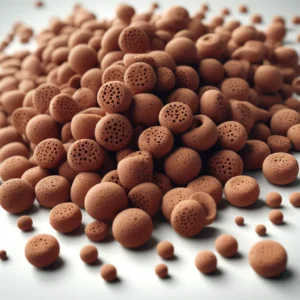
Hydroponics, the method of growing plants without soil, offers a fascinating and efficient way to cultivate a thriving garden. Instead of relying on traditional soil, hydroponics uses a nutrient-rich water solution to provide plants with everything they need to flourish. One of the most popular and versatile growing mediums for hydroponic systems is clay pebbles.
Clay pebbles in hydroponics are small, spherical balls made from expanded clay. Their porous structure and natural properties make them an excellent choice for supporting robust root development. Clay pebbles provide aeration, retain moisture, maintain a stable pH level, and are reusable, offering a sustainable solution for your hydroponic system.
If you’re looking to enhance your hydroponic setup, exploring the benefits of clay pebbles in hydroponics could be a game-changer. This guide will delve into why and how to successfully integrate clay pebbles into different hydroponic systems and provide tips for maximizing their efficacy in your garden.
Why Use Clay Pebbles in Hydroponics?
Clay pebbles offer a multitude of advantages over traditional growing mediums, making them a preferred choice for many hydroponic gardeners. Here’s a breakdown of their key benefits:
Excellent aeration
- The porous structure of clay pebbles allows ample air spaces, ensuring that your plant roots have access to the oxygen they need for healthy growth and nutrient uptake. This helps prevent root rot, a common issue in overwatered hydroponic systems.
Moisture retention
- While promoting excellent drainage, clay pebbles also retain some moisture within their pores. This helps keep the root zone moist between watering cycles, reducing the risk of your plants drying out.
pH neutral
- Clay pebbles themselves have a neutral pH, meaning they won’t drastically alter the pH of your nutrient solution. This provides stability for your plants, allowing them to absorb nutrients efficiently.
Reusable and sustainable
- Unlike some growing media, clay pebbles can be thoroughly washed and reused for multiple growing cycles. This makes them an economical and environmentally friendly choice for long-term hydroponic gardening.
Preparing Clay Pebbles for Use
Before incorporating clay pebbles into your hydroponic system, it’s crucial to prepare them properly. This ensures they are clean, stable, and ready to support your plants.
Importance of rinsing
- New clay pebbles often come with a layer of dust. Thoroughly rinse them in a bucket or colander under running water until the water runs clear. This removes any dust or debris that could potentially clog your system or alter the pH of your nutrient solution.
Soaking (optional)
- While not strictly mandatory, soaking clay pebbles in pH-adjusted water for 24 hours before use offers additional benefits. This presoaking helps to further stabilize the pH of the pebbles, minimizing potential fluctuations in your nutrient solution. It also allows the clay pebbles to fully absorb water, further optimizing their moisture retention capabilities.
Using Clay Pebbles in Different Hydroponic Systems
Clay pebbles are incredibly versatile and can be adapted to various common hydroponic systems. Let’s explore how they’re used in some of the most popular techniques:
Deep Water Culture (DWC)
- In DWC systems, plant roots are suspended directly in a nutrient-rich solution. Clay pebbles provide support by filling a net pot where the plant is placed. Their porous nature allows roots easy access to oxygen as they extend into the reservoir.
Ebb and Flow (Flood and Drain)
- Ebb and flow systems periodically flood the growing tray with nutrient solution, which then drains back to the reservoir. Clay pebbles fill the growing tray, offering a medium for plant roots to anchor themselves and providing excellent drainage during the “ebb” phase.
Drip Systems
- In drip systems, nutrient solution is delivered directly to the base of the plants. Clay pebbles are often used as a top layer in the pots or containers, helping to retain moisture, prevent evaporation, and provide additional support to the plants.
Nutrient Film Technique (NFT)
- NFT systems use a thin film of nutrient solution that flows over the plant roots. Clay pebbles have a more limited use in NFT systems, sometimes used in small quantities around the base of plants for initial support.
Planting with Clay Pebbles
Clay pebbles offer a straightforward way to both start seeds and transplant seedlings into your hydroponic system.
Seed starting:
- Many plants can be started directly in clay pebbles. Simply fill a net pot or seed-starting tray with rinsed clay pebbles. Moisten them, then place the seeds on top or gently push them just below the surface. Ensure the seeds remain moist until they germinate.
Transplanting seedlings
- When transplanting seedlings that were started in another medium (like rockwool), follow these steps:
- Gently rinse the roots: Carefully rinse the roots of the seedling to remove most of the original growing medium.
- Place in a net pot: Fill a net pot with rinsed clay pebbles. Create a small space in the center and gently position your seedling, ensuring the roots make contact with the pebbles.
- Secure the plant: Add more clay pebbles around the seedling to secure it in place.
Maintenance and Best Practices
While clay pebbles offer a low-maintenance growing solution, following some key practices will ensure your hydroponic system and plants thrive.
Nutrient solution monitoring
- Regularly check the pH and nutrient levels (EC or PPM) of your solution. Adjust them as needed to match the specific needs of your plants. A balanced nutrient solution is crucial for healthy growth.
Regular cleaning
- Between growing cycles, it’s important to thoroughly clean your clay pebbles, net pots, and system components. This prevents the buildup of algae, bacteria, and salt deposits from nutrients, which could affect future plant health.
Choosing the right size
- Clay pebbles come in various sizes. Smaller pebbles are suitable for seedlings and smaller plants, while larger ones provide better support for larger, heavier plants. Consider the size of your plants and the type of system you are using when selecting the appropriate clay pebble size.
To Sum it Up
Clay pebbles offer a remarkably efficient and sustainable way to elevate your hydroponic garden. Their advantages in aeration, moisture management, stability, and reusability make them a valuable investment for hydroponic enthusiasts of all levels.
If you’re looking to optimize your hydroponic system, consider incorporating clay pebbles. With a little preparation and attention to basic maintenance, you can reap the benefits of this versatile growing medium and enjoy a thriving, healthy hydroponic garden. If you are looking for one, I recommend the Farmstand. It is an all in one quality system. Check it out for yourself.
FAQ: Clay Pebbles in Hydroponics
Q1: Can I reuse clay pebbles?
A1: Yes! One of the significant advantages of clay pebbles is their reusability. Thoroughly clean and rinse them between growing cycles, and they can be used multiple times.
Q2: Do I need to sterilize clay pebbles before reusing them?
A2: While not always mandatory, sterilizing clay pebbles before reuse is highly recommended. This helps prevent the spread of potential pathogens or lingering salt buildup from previous nutrient solutions. You can sterilize them using a diluted hydrogen peroxide or bleach solution.
Q3: Are clay pebbles suitable for all types of plants?
A3: Clay pebbles work exceptionally well for a wide range of plants, including vegetables, herbs, and many flowering species. Plants with extensive root systems that thrive in well-aerated environments tend to do particularly well with clay pebbles.
Q4: Can I mix clay pebbles with other growing media?
A4: Yes, clay pebbles can be mixed with other growing media like coco coir or perlite to adjust drainage and moisture retention properties.
Q5: Will clay pebbles float in water?
A5: Initially, new clay pebbles might float. However, after soaking and with repeated use, they typically become heavy enough to sink.
Q6: Can clay pebbles become too compacted?
A6: Over time, especially in flood and drain systems, clay pebbles can become slightly compacted. Periodically giving them a gentle stir helps improve airflow and drainage.
Q7: Are clay pebbles messy?
A7: New clay pebbles release some dust initially, so thorough rinsing is essential. Once cleaned, they are relatively mess-free compared to some other growing media.
Q8: Do clay pebbles affect the pH of my nutrient solution?
A8: Clay pebbles themselves are pH neutral. However, over a long period, they might absorb some nutrients, potentially causing minor pH fluctuations. Regular monitoring and adjusting your nutrient solution is recommended.
Q9: Are there different sizes of clay pebbles?
A9: Yes, clay pebbles come in various sizes. Choose smaller sizes for seedlings and smaller plants, and larger sizes for more robust plants with extensive root systems.
Q10: Where can I buy clay pebbles?
A10: Clay pebbles are readily available at hydroponic supply stores, many garden centers, and online retailers.

